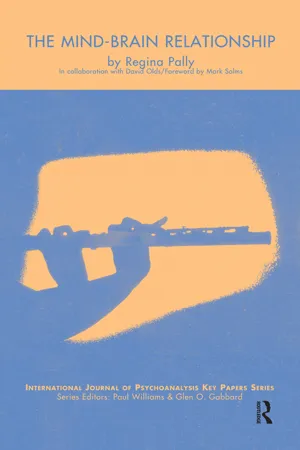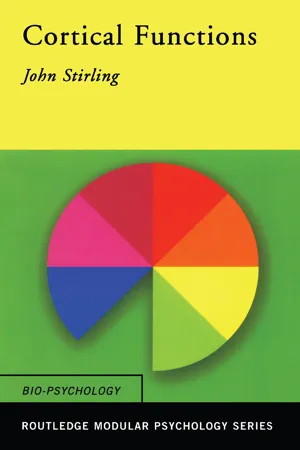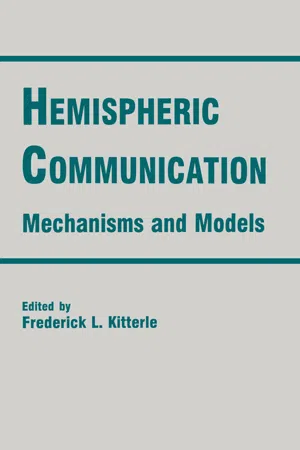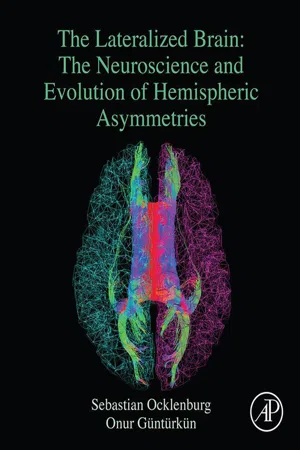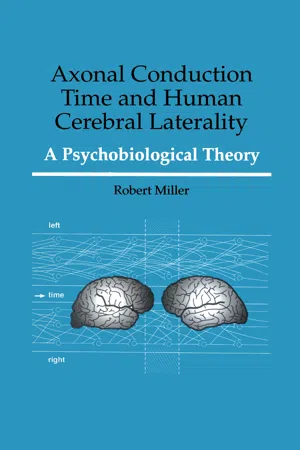Psychology
Hemispheric Lateralisation
Hemispheric lateralization refers to the specialization of functions in the two hemispheres of the brain. The left hemisphere is typically associated with language, analytical thinking, and logical reasoning, while the right hemisphere is often linked to creativity, spatial awareness, and emotional processing. This concept highlights the distinct roles each hemisphere plays in cognitive and behavioral functions.
Written by Perlego with AI-assistance
Related key terms
Related key terms
1 of 4
Related key terms
1 of 3
11 Key excerpts on "Hemispheric Lateralisation"
- eBook - ePub
- Regina Pally(Author)
- 2018(Publication Date)
- Routledge(Publisher)
In this century, in the 1930s, Lange revitalised interest in the central importance of the right hemisphere. He recognised that the right hemisphere provides a general contextual background to a person’s world view. During the 1960s the initial work of Sperry and Gazzaniga (Gazzaniga et al., 1962) at first seemed to corroborate the ‘two minds, two consciousnesses’ view held by some late nineteenth-century scientists. Subsequent work, however, resulted in the now generally accepted ‘asymmetric but integrated’ perspective. The right and left cerebral cortex are each lateralised for specialised functions, but in the healthy brain the two hemispheres share their information and operate collaboratively (Joseph, 1996; Deacon, 1997; Gazzaniga, 1995; Ornstein, 1997).Research regarding latéralisation of specialised functions pertains mostly to cortical functions. However, it must be remembered that specialised functions of each cortex are influenced by input from subcortical structures as well as from other cortical sites in the same or opposite hemisphere. According to Deacon, functional asymmetry evolved because in certain circumstances organisms must prioritise, and have only one goal, express only one action, or speak only one thought. For these particular functions only one hemisphere must have the advantage.Neuroscientists assume that the reason that language and fine motor movements are lateralised to the left cerebral cortex and emotion and musical ability to the right cerebral cortex is a fundamental difference between the left and right cortices with respect to information processing (Galin, 1974; Tucker, 1981). The left is better at analysing rapid temporal-sequential aspects of information. Therefore the left hemisphere more readily identifies ‘details’ and notices precise distinctions, rendering an advantage to the left in the specialised functions of language, causal relationships and fine motor movements. By contrast, the right is better at analysing the global, overall relationship aspects of information. Therefore the right more readily identifies context and gets the overall picture of the situation, giving an advantage to the right hemisphere in processing social interactions, emotional experience and visual-spatial tasks. One metaphor often used is that the left is a digital ‘computer’ and the right an analogue ‘computer. Another is that the left provides the ‘text’ and the right the ‘context’.Hemispheric dominance is relative, not absolute. Ornstein (1997) compares this to the ‘winner takes all’ in politics, where a 51 per cent majority can win the election. Translated into neuroscience this means a hemisphere does not function 100 per cent in its area of speciality, only relatively - eBook - ePub
- John Stirling(Author)
- 2020(Publication Date)
- Routledge(Publisher)
4Lateralisation
Introduction Structural differences The split brain syndrome Callosal agenesis Asymmetries in normal individuals What is lateralised? Inter-hemispheric transfer via the corpus callosum Individual differences in brain organisation SummaryIntroduction
As I mentioned in Chapter 2 , at first glance, the two cortical hemispheres look pretty much like mirror images of each other. Yet closer inspection reveals many subtle differences in structure. Behavioural studies suggest differences in function too. The study of lateralisation is the study of the distinct patterns of psychological functioning seen in the two hemispheres. Hemispheric specialisation is also sometimes known as asymmetry of function because of the different (asymmetric) responsibilities that psychologists have observed. In this chapter, we consider the various ways that scientists have examined this asymmetry, and the conclusions that they have drawn from their research.Structural differences
The two hemispheres of the adult human brain are not mirror images of one another, and differ in a number of characteristic ways.• Viewed from the top of the head, the right frontal lobe extends further forward, and the left occipital lobe further back. • The dividing line between the frontal and temporal lobes (known as the Sylvian fissure) is longer and less sloped on the left side than the right. • A region of temporal lobe adjacent to the Sylvian fissure is much larger on the left than the right. This area of cortex has been linked to language comprehension for at least 100 years. - eBook - ePub
Hemispheric Communication
Mechanisms and Models
- Frederick L. Kitterle(Author)
- 2020(Publication Date)
- Psychology Press(Publisher)
2 Neuroanatomical Bases of Hemispheric Functional Specialization in the Human Brain: Possible Developmental Factors 1 Sandra F. Witelson McMaster UniversityFunctional Asymmetry: Nature and Ontogeny
Hemispheric functional specialization or functional asymmetry is a well-established characteristic of functional organization in the human brain. In essence, the right and left hemispheres have different roles in mediating various behaviors and higher mental processes. Tasks involving speech production, phonemic discrimination; comprehension of oral and written language; the ability to write; performance of voluntary finger, limb, and oral movements; and the perception of sequences of stimuli are more dependent on left- than right-hemisphere functioning in most people. In contrast, tasks involving the perception of two- and three-dimensional visual or tactual shapes, spatial position and orientation of stimuli, the perception of faces and colors, mental rotation of three-dimensional shapes, the ability to direct attention to both lateral sensory fields, the perception of musical chords and melodies, aspects of the perception of emotional stimuli and prosodie features of speech, and the abilities to dress oneself and to construct block models are more dependent on the right hemisphere. In the past decade, numerous books have summarized these findings based on the study of brain-damaged people with unilateral lesions, people who have undergone commissurotomy, and neurologically intact people who were tested with various behavioral and perceptual tests involving right- and left-sided input or output (e.g., Beaton, 1985; Boller & Grafman, 1988-1990; Bradshaw & Nettleton, 1983; Bryden, 1982; Corballis, 1983; H. Damasio & A. Damasio, 1990; Geschwind & Galaburda, 1984; Hannay, 1986; Heilman & Valenstein, 1985; Heilige, 1983; Kolb & Whishaw, 1990; Molfese & Segalowitz, 1988; Ottoson, 1987).However, several key issues related to hemispheric specialization remain unresolved. First, the lists of tests that are more dependent on one hemisphere or the other are continually expanding. There is no demonstration, however, of what specific cognitive functions are common to each set of skills and are indicative of the type or types of processing that each hemisphere is specialized for. The numerous dimensions postulated for hemispheric differences, such as verbal versus nonverbal or analytic versus synthetic, are merely inferred hypotheses derived from the numerous tasks studied, of what the essential functional characteristics of the hemispheres are. Moreover, it has been shown that it is not only the nature of the task stimuli, but also the strategy or process the subject uses to perform the task, that determines which hemisphere is dominant in processing for that task. Currently, a widely used working hypothesis is that the left hemisphere is specialized for analytic, sequential, time-dependent functions, and the right hemisphere is specialized for synthetic, spatial perceptual functions (e.g., Bradshaw & Nettleton, 1983). - eBook - ePub
Brain, Attachment, Personality
An Introduction to Neuroaffective Development
- Susan Hart(Author)
- 2018(Publication Date)
- Routledge(Publisher)
In this chapter, I will review some aspects of lateralization and its importance for certain functions. The lateralization of the brain is an area of particular theoretical dispute, and much of the theory in the area is speculative in nature. It is, however, indisputable that the brain is lateralized, and hopefully, future research will be able to provide a clearer picture of the relationship between neurophysiological differences and function.History
As early as 1904, it was clear that the brain is not only lateralized on the neocortical level but also on a deeper level, in brainstem functions. The limbic system is also lateralized, and in the human brain emotional facial expressions are processed in the right hemisphere. Recent neurophysiological research shows that hemispheric lateralization is not just found in primate brains but is also a feature of lower mammals, fish, reptiles, birds, etc. The evolutionary advantage of brain lateralization has long been the topic of speculation, and today it is generally believed that lateralization has developed in order to make room for new skills without the loss of existing skills. Lateralization makes room for additional skills because functions can be divided between the right and left hemisphere, and the two hemispheres are free to specialize in different functions (Gazzaniga, 1999; Geschwind & Galaburda, 1987; Schore, 2003b).Some functions have had to give way to new ones. For example, the expansion of the parietal and frontal lobes probably took place at the cost of the visual cortex. A look at the skulls of some of the prehistoric humans who lived some two million years ago reveals that their skulls were constructed to accommodate a much larger visual cortex than is found in modern man. In particular, the frontal motor areas in the left hemisphere expanded at this time, while there are no major changes in the corresponding areas in the right hemisphere. This development probably took place in order to accommodate language, since this is the region where we find the neural roots of language (Gazzaniga, 1999; Hansen, 2002). - eBook - ePub
- Simon Greene(Author)
- 2013(Publication Date)
- Psychology Press(Publisher)
Some authors have suggested that people may be characterised by their “dominant” hemisphere; left hemisphere people are analytical, verbal, rational, scientific, whereas their right hemisphere counterparts are creative, intuitive, visuo-spatial, artistic, emotional. However, it is only in the artificial conditions of the laboratory that we can even try to separate out hemisphere functions. Any human endeavour is bound to contain elements of both “styles”. Einstein was a scientist, but the theory of relativity was also a creative enterprise—the original ideas did not emerge fully formed. Leonardo da Vinci was perhaps as great an artist and inventor as has ever lived, but all his work shows tremendous attention to detail. Even for us lesser mortals virtually everything we do represents contributions from both hemispheres; that is inevitable given that we have a corpus callosum to ensure that the activities of the two sides of the brain are synchronised and integrated. Despite the attraction of seeing the hemispheres in general terms, as either analytic or visuo-spatial, most people would accept that the left hemisphere does contain specific mechanisms for language. Of all the tests of hemisphere lateralisation, the most reliable is the Wada test for speech laterality. This technique uses the fact, mentioned earlier, that each hemisphere has a separate blood supply. An anaesthetic (e.g. sodium barbital) is injected into the carotid artery supplying one hemisphere. The patient is asked to read aloud. If the anaesthetised hemisphere contains the language system, then speech will temporarily fade away; the test is used to check on speech laterality before brain surgery. The Wada test shows that over 95% of right-handed subjects have speech in the left hemisphere. Note that this is a test of reading comprehension and speech production together. Tests of language comprehension alone (i.e - eBook - ePub
The Divided Therapist
Hemispheric Difference and Contemporary Psychotherapy
- Rod Tweedy(Author)
- 2020(Publication Date)
- Routledge(Publisher)
Chapter 10The formation of two types of contexts by the brain hemispheres as a basis for a new approach to the mechanisms of psychotherapy
Vadim S. RotenbergThe investigation of brain asymmetry has developed in two different directions. On the one hand, neurologists for a century and a half collected data of the role of local brain structures of both hemispheres in the realization of some definite mental and behavioural functions. This direction of investigation is now equipped with modern methods of brain investigation such as positron emission tomography and fMRI (see Craik et al., 1999).The investigations performed on epileptic patients with bisected brains also brought much unexpected data. It was shown that in these patients, even in right-handed subjects, the right hand could not copy simple geometric figures and was unable to build simple constructions of child bricks, while the left hand performed all these tasks easily. With closed eyes, the patient could not recognize even quite familiar objects with the right hand, while the left hand did this immediately. If the information was presented to the left visual field (right hemisphere) the subject’s behaviour was relevant to the content of this information, but the subject was unable to explain the reasons for his/her behaviour. Moreover, patients with bisected brains periodically demonstrated the behavioural signs of inner motivational conflict which was not realized. Thus, one patient complained that he volitionally embraced his wife with his right hand (managed by the left hemisphere), and at the same time unexpectedly pushed her away with his left hand – a story which in another condition in subjects with undivided brains might immediately bring a psychodynamic interpretation.The first attempts to interpret the data of investigations performed on these patients were superficial and ignored the possible relationships of this data to essential psychological functions. The most popular assumption proposed that brain hemispheres deal with different types of information: the left hemisphere processes special signs like those present in natural and artificial languages, while the right hemisphere processes the natural nonverbal information such as images, melodies, and intonations of voice, and is responsible for orientation in space and within the subject’s own body. This concept seemed to be confirmed by the outcomes of the organic damages of left and right brain hemispheres. For instance, damage to the left temporal lobe is accompanied by motor and sensory aphasia while damage to the right parietal lobe is associated with disorientation in space. - eBook - ePub
The Lateralized Brain
The Neuroscience and Evolution of Hemispheric Asymmetries
- Sebastian Ocklenburg, Onur Güntürkün(Authors)
- 2017(Publication Date)
- Academic Press(Publisher)
Chapter 4Language and the Left Hemisphere
Sebastian Ocklenburg and Onur GüntürkünAbstract
Language is our most important means of communication. Most, but not all, aspects of language processing are controlled by the left hemisphere, and language lateralization is one of the major topics in research on functional hemispheric asymmetries. This chapter starts with an outline of the most commonly used techniques to determine the language-dominant hemisphere, including the Wada test, dichotic listening, and functional magnetic resonance imaging. Subsequently, the neuroanatomy of the language system, including Broca’s area, Wernicke’s area, the posterior speech area, and the arcuate fasciculus is described. Afterwards, right-hemispheric contributions to language as well as atypical language lateralization and language lateralization in bilinguals are highlighted. The chapter concludes with a section on lateralization in nonvocal languages such as whistle- or sign languages. - eBook - ePub
- R. M. Granovskaya, I. J. Bereznaya, Alla N. Grigorieva(Authors)
- 2013(Publication Date)
- Psychology Press(Publisher)
Analysis of various findings on differences in the character of time-space relations revealed by right and left hemispheres allows us to form the following interpretation. The establishment of time-space relations in the “here and now” field is inherent, to a greater degree in the right hemisphere because it processes data in real time and space. It simultaneously reveals an object’s structural properties, and provides a whole representation of spatial interrelations among all parts of the object. The left hemisphere generates languages. The words serving as symbols have no direct association with corresponding objects; the grammar of their relations is a logically organized structure. These logical relations revealed by the left hemisphere can characterize associations between past and future events and describe objects remoted from the now perceived situation. This hemisphere is capable of revealing relations that cannot be represented visually.Grasping the Meaning and a Degree of Situational AwarenessSome researchers studying cerebral lateralization have concluded that the right hemisphere performs a global evaluation of a given situation’s significance, grasping the meaning of signals for both outer and inner worlds [40 , 154 ]. Defects in these higher faculties are dramatically manifested in patients with lateral frontal lesions. Patients with right-sided lesions show the disability to estimate their own state; they are unable to relate the story meaning even when asked direct questions. In contrast, patients with left-sided lesions perform the task normally. Artemieva [95 ] assumes frontal lesions lead to defects in the ability to register one’s own current activities or state. Patients with left frontal lesions lose the ability to answer the question “What is happening to me?” While those with right frontal lesions cannot answer “What is the meaning of what is happening to me?”Any evaluation implies comparing one object with a standard or criterion. According to many sources [110 , 169 , 171 - eBook - ePub
Axonal Conduction Time and Human Cerebral Laterality
A Psycological Theory
- Robert Miller(Author)
- 2019(Publication Date)
- CRC Press(Publisher)
5 Perceptual Aspects of Lateralization: Theory and Predictions5.1 Introduction
From the morphological evidence reviewed above, the hypothesis that there be a richer repertoire of delay lines between different cortical areas in the left hemisphere compared to the right is at least plausible, though critical tests of the morphological aspects of the hypothesis have not yet been conducted. The evidence, such as it was, implied a global difference between the hemispheres, not confined selectively to the areas known to be primarily involved in language. This in turn has another major implication: It encourages us to think that the functional difference between the sides can be demonstrated not only with respect to language functions but with respect to a wide variety of other functions (both sensory and motor) which depend on the same lateralized differences in morphological substrate. Therefore, two further important questions are posed: What is the full range of functional differences between left and right hemispheres? Can they all be explained as direct or indirect consequences of differences between the hemispheres in the degree of temporal dispersion of signals within each hemisphere?In the present chapter, predictions will be made about the differences between the hemispheres in processing sensory signals, and in the following chapter corresponding evidence is reviewed. Admittedly, the hypothesis of the structural basis for interhemispheric differences also lends itself to predictions about differences in programming of motor output, and has implications for the higher cognitive functions of the forebrain. However, it is much easier to design experiments to evaluate temporal aspects of sensory processing than those of motor programming or cognitive processes. Discussion of the lateral differences in motor programming is therefore deferred to Chapters 8 and 9 , when they can be placed in an appropriate theoretical framework. Laterality of higher cognitive functions of the forebrain is discussed in Chapter 10 - eBook - ePub
Neural Circuit and Cognitive Development
Comprehensive Developmental Neuroscience
- Bin Chen, Kenneth Y. Kwan(Authors)
- 2020(Publication Date)
- Academic Press(Publisher)
Shen, 2015 ). Again, this work is most meaningful when network features are linked to behavior.27.4.3.1. Lateralization
Lateralization, also referred to as hemispheric specialization or functional asymmetry, has been a historically popular explanation for cognitive sex differences, particularly for spatial and language skills. Typically, the left hemisphere, which houses both Broca's and Wernicke's areas, is dominant for sequential processing, including language, and the right hemisphere is dominant for simultaneous processing, including spatial skills (for reviews, see Bryden, 1982 ; Hall et al., 2008 ; Kansaku and Kitazawa, 2001 ; Kimura, 1999 ). Data going back several decades, derived from patients with brain damage and behavioral tasks in typical individuals (e.g., split-field visual tasks, dichotic listening, and electroencephalogram asymmetry), suggest that women are less lateralized than men, especially for language (Bryden, 1982 ; Gur and Gur, 2017 ; McGlone, 1980 ). The topic has also been studied using fMRI, but results are often task and method dependent and subject to misinterpretation. For instance, lateralization must be explicitly tested by comparing activation in the two hemispheres; it is not sufficient to show that the activity of only one hemisphere is above baseline or that there are significant sex differences in specific regions of a single hemisphere. When the correct analyses are conducted, women generally show less lateralization than men, but the effect is small. Women's reduced lateralization has been suggested to be linked to greater interhemispheric communication facilitated by their larger interhemispheric commissures and is consistent with data showing their greater interhemispheric structural connectivity (Halpern, 2012 ; Hines et al., 1992 ; Ingalhalikar et al., 2014 - eBook - ePub
Introduction to Psycholinguistics
Understanding Language Science
- Matthew J. Traxler(Author)
- 2011(Publication Date)
- Wiley-Blackwell(Publisher)
lateralized presentation of words (e.g., Long & Baynes, 2002). To test whether the two hemispheres cooperate, or if one hemisphere processes words all by itself, researchers have studied what happens when the same word is presented to both hemispheres simultaneously compared to what happens when one word is presented to the left hemisphere, and a different word is presented to the right hemisphere. If the two hemispheres normally cooperate during word identification, then presenting the same word to both hemispheres should help; and presenting different words to the two hemispheres should cause interference. If only one hemisphere normally participates in word identification, then the subject’s response should be the same whether the same or different words are presented to the two hemispheres (because the subject’s response depends only on the dominant hemisphere).A word can be presented to one hemisphere without the other hemisphere being directly stimulated by the word because of the way the visual system is configured. The left half of each retina in the eye sends signals only to the right side of the brain; and the right side of the retina sends signals only to the left half of the brain. As a result, stimuli in the left visual field (or LVF) will be processed first by the right side of the brain; and anything that appears in the right visual field (or RVF) will be processed first by the left half of the brain. The LVF includes everything to the left of the fixation point , the point in space that you are looking at. The RVF includes everything to the right of the fixation point. Of course, the two hemispheres normally share information via the corpus callosum, but visual information is divided between the two halves of the brain and there is some noise in the process of transferring information between the two hemispheres. As a result, the directly stimulated hemisphere gets a head start on processing the stimulus, and it has a more accurate, higher quality picture to work with (Zaidel, Clarke, & Suyenobu, 1990). In divided visual field
Index pages curate the most relevant extracts from our library of academic textbooks. They’ve been created using an in-house natural language model (NLM), each adding context and meaning to key research topics.
Explore more topic indexes
Explore more topic indexes
1 of 6
Explore more topic indexes
1 of 4
